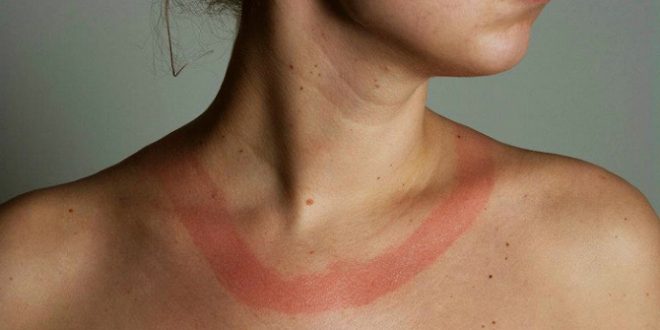Skin allergies appear as a red, itchy rash. They occur when something touches your skin and your immune system sees it as an invader and sends antibodies to fight it. Like other allergies, skin allergies can develop (seemingly) out of the blue. You might have been able to touch certain things for many years and then suddenly develop a rash.
You can have an allergy to many different things, including plants (poison ivy), dyes, fragrances, pollen, chemical sprays, cleaning products, powders, fibers, latex or metal (nickel is the most common metal that causes allergic reaction).
Diagnosing allergies
Skin tests can show what you are sensitive to, but may not pinpoint specific allergies. Skin tests, such as the TRUE (Thin-Layer Rapid Use Epicutaneous) test, will expose you to a variety of substances according to the FDA. The TRUE test has three panels, with 12 patches on each panel, and each patch is a different possible allergen. After you wear the patches for two days, your doctor will look for a reaction and determine which substance you reacted to. You might need to come back after 10 days as some reactions do not show up until then.
Your doctor might also work with you in determining other substances you are allergic to and talk to you about substances you come in contact with at home, work, school or during other activities, such as hobbies.
Treatment
Over-the-counter medications often work to relieve the discomfort associated with skin allergies. These include:
- Hydrocortisone cream
- Calamine lotion
- Antihistamines
- Cold compresses
- Oatmeal baths
Different methods might work best on specific allergens; for example, hydrocortisone cream works well on plant allergens. If over the counter methods don’t work, your doctor can prescribe stronger medicines.
Most of the time skin allergies aren’t life threatening, but in rare cases you can have a reaction called anaphylaxis which can make it hard to breathe. If you have this type of reaction, you should seek medical attention immediately.
Nickel allergy
One of the most common causes of allergic contact dermatitis is nickel, with more than 18 percent of people in North American having an allergic reaction, according to the American Academy of Dermatology.
If you are allergic to nickel, you will need to take steps to avoid having this metal touch your skin.
Wear jewelry that is nickel free, hypoallergenic, made from surgical grade stainless steel or 18, 22 or 24 karat gold, sterling silver or platinum, and use leather or cloth wristband straps.
Replace snaps, metal buttons and zippers with plastic ones.
Use a protective cover on electronics.
Avoid food products such as soy products, licorice, buckwheat, cocoa powder, clams, cashews and figs as they can contain nickel.
Pay attention to household products that are metal: keys, razors, pots and pans, eyeglasses, and look instead for products made from brass, titanium or stainless steel.
Latex allergies
According to the American College of Allergy, Asthma and Immunology, latex allergies are triggered by natural rubber latex, which comes from the sap of the rubber tree. Synthetic rubber products do not trigger allergic reactions.
Some products made with natural latex include:
- Disposable gloves
- Dental dams
- Intravenous tubes
- Syringes
- Stethoscopes
- Catheters
- Bandages
- Condoms
- Handbags
- Balloons
- Athletic shoes
- Tires
- Tools
- Elastic waistbands
- Rubber toys
- Baby bottles
- Nipples
- Pacifiers
If you have a latex allergy, you might experience hives, itching, swelling, stuffy or runny nose, wheezing, chest tightness and difficulty breathing. Symptoms from a latex allergy often appear within a few minutes after exposure.
Many medical supplies, such as disposable gloves, contain latex. In a medical emergency, especially if you are unable to communicate, being exposed to latex can cause additional medical problems. Wearing a medical alert identification, or carrying one in your wallet, can literally save your life.
Because these allergies can lead to anaphylaxis, it is prudent to carry an epinephrine injector with you.
Chemical allergy
According to the American Academy of Dermatology, chemical allergies are called irritant dermatitis. These occur when toxic substances, such as battery acid, bleach or pepper spray touch your skin. Surprisingly, repeated exposure to water, which can cause dry or cracked skin, can also lead to a skin reaction. People who work with chemicals, such as beauticians and car mechanics, can get irritant dermatitis.
If you have a chemical skin reaction, talk with your doctor. It is best to treat the rash early, as it can lead to infection.
 Only Ayurved आयुर्वेद जीवन जीने की कला हैं, हम बिना दवा के सिर्फ अपने खान पान और जीवन शैली में थोड़ा बदलाव कर के आरोग्य प्राप्त कर सकते हैं।
Only Ayurved आयुर्वेद जीवन जीने की कला हैं, हम बिना दवा के सिर्फ अपने खान पान और जीवन शैली में थोड़ा बदलाव कर के आरोग्य प्राप्त कर सकते हैं।



















